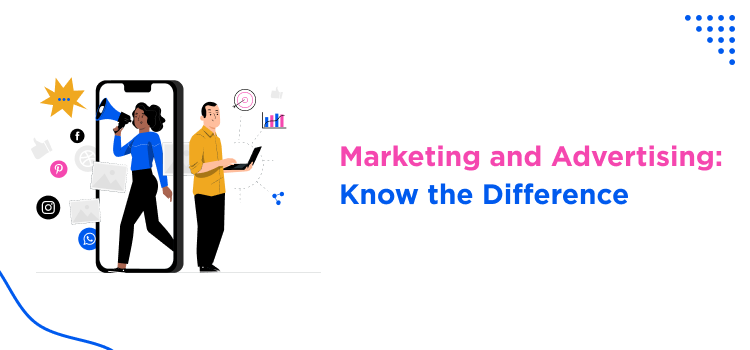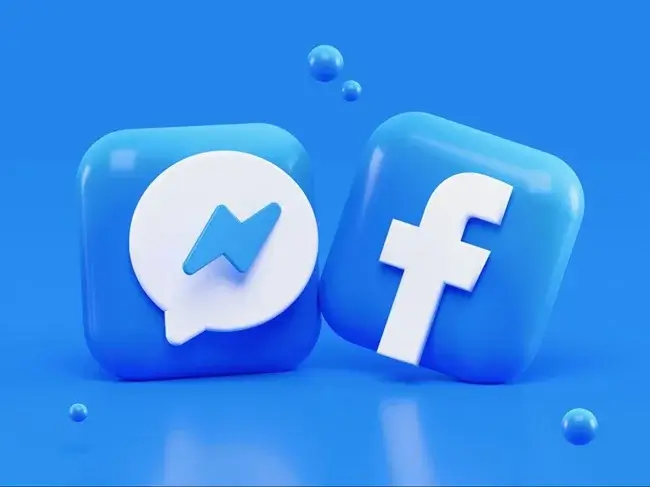Marketing and Advertising: Know the Difference (2025)

Marketing and advertising are interconnected terms and pretty easy to understand. These terms are fundamental to promote your product or service and earn maximum profits. But what is the main difference and how both of these help your business? Let’s uncover it in our detailed marketing vs advertising guide!
What is Marketing, and What’s Its Purpose?
Marketing is all about strategy. Strategy is about the long-term promotion and success of your business. It’s a process of consciously creating, communicating, and delivering value. This eventually adds up to drive sales and build brand recognition.

The cornerstones of marketing rely on understanding your audience, understanding a strong value proposition, and building a brand that people know and love. Marketing is built on top of a multi-channel approach – SEO, social media, email, and paid ads that help you reach the right people.
Marketing is beyond promoting your product and service. To put it simply, it has four Ps that are product, price, placement, and promotion.
Whether for physical or digital products, marketing relies on these key terms that, as a marketer, you will be dealing with constantly:
Marketing Terms to Increase Your Understanding
- Brand Awareness This helps in increasing your familiarity with your audience. The fact that your audience knows how you provide solutions with your product and service.
- Target Audience A specific group of consumers (demographics, interests, problems) most likely to be interested in your product or service.
- Value Proposition The unique benefit (different from the others) your product or service offers to customers.
- Customer Persona This helps in marketing tactics to understand interests, needs, and pain points of your buyers. There is a nice tool to create such.
- Unique Selling Proposition (USP) This helps your marketing team decide what makes your product or service stand out from competitors.
- Marketing Funnel Marketing teams design a smooth customer journey that helps them go from brand awareness to purchase.
- Call to Action (CTA) A piece of text that you add to emails, websites and other places to encourage users to take a specific action that provides them quick information or further journey. (e.g., “Start Free Trial Now”).
- Conversion Rate This shows how your website traffic supports or impacts purchase and other favorable actions.
- Return on Investment (ROI) This is how much money you earn – the profitability from marketing efforts.
- Lead Generation Leads are potential buyers and your marketing efforts should be directed at converting leads to buyers.
As a marketing agency, you must know about traditional and digital marketing tactics. Both of these are pillars to creating a brand that is known by a mass. Let’s take a look at these two concepts.
Digital vs Traditional Marketing: Key Differences<
Traditional Marketing
Basically, it includes the marketing methods that have been used for a long time. These methods are tried, tested, and loved by the audience. These include television ads, radio ads, newspaper & magazine ads, billboards, flyers, postcards, brochures etc.
Boomers, Gen X and Millennials have grown up with traditional marketing. They loved vibing to various radio jingles and TV ads. Or even cutting up newspaper sections for collection, projects, or discount vouchers. Thus, traditional marketing works for you if you are an established brand, local business, bring nostalgia, or have a target audience among this age group.
Digital Marketing
Digital marketing is about leveraging various online marketing strategies. With easy access to digital screens and high speed internet, people are spending more and more time online. Be it for reading, engaging, listening to music, attending events, etc.
Digital marketing includes various tactics like social media marketing, email marketing, content marketing, SEO, etc. If you want real-time engagement with highly targeted marketing, this is for you. Furthermore, if you want to build a social media presence or digital presence, this is for you.
Eventually, every brand tries to find their mix of traditional and digital marketing. Based on the nature of your business and target audience, you must work out on both types of marketing to gain maximum benefits.
What is Advertising?
As you might have guessed, marketing deals with a longer list of tasks and terms! Advertising, in its turn, is a typically paid method within marketing that aims to reach and speed up conversions.
For example:
- Retargeting ads in Paid Facebook, Google, or LinkedIn. Here, you invest money to get back with your previous loyal customers.
- Exclusive offers (when promoted via ads) – if discounts or VIP content are pushed through paid ads, they count as advertising.
- Gamification-based ads to ‘speak’ the language of the ‘achievement-driven’ customers.
- FOMO-driven ads wherein audience are excited to get a product or service because their peers have it already.
- Testimonial and community highlight ads – to feature testimonials and drive new subscribers.

A huge part of ads are performed in social media today, so there is an entire branch of social media marketing, which may include such popular areas:
- Engagement rate
- Influencer marketing
- Hashtag strategy
- Social listening
- Social proof
- Viral posts
- Community management
- Facebook ads
- Instagram reels
- LinkedIn marketing
Types of Advertising
With the advent of digital media, there are various advertising agencies that work towards multiple advertising strategies. There are multiple types of advertising that an ad agency dips their feet in to get maximum benefits. That too, in a short time
- Facebook Advertising: When you use Facebook or Meta Ads to promote your products or services, you are engaging in Facebook advertising. This online advertising is interlinked with the Instagram platform. Herein, you get a complete Meta Business Suite from which you can set up and manage your business advertising.
- Local Advertising: In order to target customers from a specific geographic location, you indulge in local advertising. From offline to online methods, local advertising includes multiple ways. From flyers to billboards, local newspaper ads, social media geolocation and geotargeting, and promoting Google My Business profile.
- Tik Tok Advertising: To engage with a highly active audience, you can use tik tok advertising and leverage the short-form video content. It provides ad formats like in-feed ads, brand hashtag challenge, and top view ads. You can easily use its demographic targeting options to reach a specific audience. It is one type of social media advertising.
- Google PPC Ads: With this digital advertising model, you pay for your ads to appear on Google’s search results. These ads are usually targeted based on keywords, audience demographics, and user behavior. These ads help lead generation by driving traffic to your site.
The Key Difference: Marketing vs Advertising
Marketing and advertising go hand in hand but understanding the key difference helps you better manage your budgets and business strategies.

Ads are smaller pieces of marketing. Marketing is a strategy, while ads are tactics and methods. Advertising serves to gain immediate results and effects (e.g. running paid ads in Facebook), relying on the decisions made by the marketing teams.
Too many complicated terms, but we can simplify your understanding with this brief marketing and advertising comparison table.
| Aspect | Marketing | Advertising |
|---|---|---|
| Definition | Long-term strategy to build relationships and brand awareness | Paid promotion to drive immediate actions and visibility |
| Focus | Engagement, retention, and trust-building | Quick reach, conversions, and sales |
| Timeframe | Long-term | Short-term |
| Examples | Email campaigns, content marketing, SEO, social media engagement, events | Google Ads, Facebook Ads, sponsored posts, retargeting ads |
| People Responsible | Marketing managers, content strategists, community managers | PPC specialists, ad managers, media buyers |
| Budget | Varies – Can be organic or paid | Requires direct spend for visibility |
| Goal | Brand loyalty, lead nurturing, customer engagement | Immediate clicks, sales, or sign-ups |
| ROI Measurement | Engagement rates, retention, community growth | CTR, conversions, ROI on ad spend |
Marketing Engagement Tactics for a Membership Site
At ARMember, we’re creating many marketing and advertising resources for promoting your membership website.

But since we’re creating a fundamentals guide for marketing vs advertising here, these are the areas where you need to work:
Ongoing Engagement
After the member onboarding, you need to keep your members always active. In addition to delivering valuable content through your courses or programs, you need to keep doing many steps:
- Email and push notifications can be automated to send regular updates, newsletters, or reminders about new content.
- Gamification and rewards work with badges or points that drive competition and progress. You can implement them easily with the right membership software.
- Host live events, like meetings or webinars for personal touch and more in-depth training.
- Build smaller member-only communities inside the membership to create discussions.
Win-back strategies
To keep up the audience’s interest in your brand and service, you should keep communicating with them. You can re-engage lapsed members – and it’s one of the tasks of your advertising and marketing strategies.
- Use Facebook, Google, or LinkedIn ads to target past members with engaging visuals and messaging.
- Feature testimonials or highlight exciting events to boost community.
- Wake up inactive users by tagging them in beneficial posts.
- Start Polls, AMAs, or contests to boost audience participation.
- Use FOMO-driven content (e.g., “Grab the exclusive deal for two days!”).
- Laderboard reset, badge rewards, or limited-time perks.
- Offer a referral bonus or other discounts.
Content marketing
Membership owners are content creators, and content marketing always prevails! Here are the key things you should understand:
- A smart and data-driven content strategy is a must to avoid topics that will never bring you a new member.
- Set blogging marketing on autopilot to bring keyword-optimized traffic.
- Evergreen content to cover most common questions related to your membership.
- Have a content calendar to track the progress of your content.
- Copywriting teams, preferably in-house, who better know the true insights of your business.
- Storytelling works for content-oriented websites and businesses.
- Infographics are easily shareable, and make sense for content sites.
- Case studies inspire your customers to register with your business.
- User-generated content (UGC) works better for driving leads.
Relationship-building marketing
Build relationships with members to power up engagement and build a stronger community with personal touch with these approaches:
- Premium articles, webinars, or masterclasses.
- Personalized outreach with direct messaging and ambassador check-ins.
- Fresh content and events.
- Success stories and interviews.
- VIP spaces.
- Member rewards for new sign-ups.
- Community ambassadors and moderator promotion.
- Exclusive meetups (virtual or in-person).
Concluding: The Difference in Marketing and Advertising
Advertising vs marketing: what should you pay attention to in the first place? A simple answer is – you need to take care of both, to have a long-term and short-term plan for the product deliverance to the market. If you are in the membership business arena, we hope our marketing and advertising tips will help you understand the areas where to put your energy first!
Related articles:





Leave a Reply
You must be logged in to post a comment.